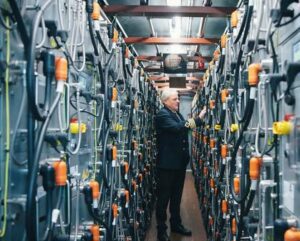
Preface. You’d need 100,000 metric tons of batteries taking 40% of cargo space to go from Asia to Europe in 31 days on an 18,000 TEU container ship, and it is hard to imagine how or how long it would take to recharge these batteries. In comparison, the same ship just needs 4,650 metric tons of diesel fuel.
At some point of oil decline, wooden sailing vessels will come back in style. It’s well past time to plant more forests in anticipation, since trees take decades to grow, and world oil production probably peaked in 2018. Forests also remove CO2, probably more than batteries when their full life cycle of mining, fabrication, and so on are considered.
Alice Friedemann www.energyskeptic.com Author of Life After Fossil Fuels: A Reality Check on Alternative Energy; When Trucks Stop Running: Energy and the Future of Transportation”, Barriers to Making Algal Biofuels, & “Crunch! Whole Grain Artisan Chips and Crackers”. Women in ecology Podcasts: WGBH, Jore, Planet: Critical, Crazy Town, Collapse Chronicles, Derrick Jensen, Practical Prepping, Kunstler 253 &278, Peak Prosperity, Index of best energyskeptic posts
***
Smil, V. 2019. Electric container ships are stuck on the horizon. Batteries still can’t scale up to power the world’s biggest vessels. IEEE spectrum.
Just about everything you wear or use around the house once sat in steel boxes on ships whose diesel engines propel them from Asia, emitting particulates and carbon dioxide. Surely, you would think, we can do better.
After all, we’ve had electric locomotives for more than a century and high-speed electric trains for more than half a century, and recently we have been expanding the global fleet of electric cars. Why not get electric container ships? Actually, the first one should begin to operate this year: the Yara Birkeland, built by Marin Teknikk, in Norway, is not only the world’s first electric-powered, zero-emissions container ship but also the first autonomous commercial vessel.
But don’t write off giant diesel-powered container ships and their critical role in a globalized economy just yet. Here is a back-of-the-envelope calculation that explains why.
Containers come in different sizes, but most are the standard twenty-foot equivalent units (TEU)—rectangular prisms 6.1 meters (20 feet) long and 2.4 meters wide. The first small container ships of the 1960s carried mere hundreds of TEUs; now Maersk’s Triple-E class ships load 18,000 TEUs, and OOCL Hong Kong holds the record, at 21,413. At the “super slow steaming,” fuel-saving speed of 16 knots, these ships can make the journey from Hong Kong to Hamburg in 31 days.
Now look at the Yara Birkeland. It will carry just 120 TEU, its service speed will be 6 knots, its longest intended operation will be 30 nautical miles—between Herøya and Larvik, in Norway—and its batteries will deliver 7 to 9 megawatt hours. Today’s state-of-the-art diesel container vessels thus carry 150 times as many boxes over distances 400 times as long at speeds three to four times as fast as the pioneering electric ship can handle.
What would it take to make an electric ship that can carry 18,000 TEUs? In a 31-day trip, today’s efficient diesel vessel burns 4,650 metric tons of fuel (bunker or diesel), each ton packing 42 gigajoules. That’s an energy density of about 11,700 watt-hours per kilogram, versus 300 Wh/kg for today’s lithium-ion batteries, a nearly 40-fold difference.
The total fuel demand for the trip is about 195 terajoules, or 54 gigawatt-hours. Large diesels (and those in the ships are the largest we have) are about 50 percent efficient, hence their useful propulsive energy demand is about 27 GWh. To match that demand, large electric motors operating at 90 percent efficiency would need about 30 GWh of electricity.
Load the ship with today’s best commercial Li-ion batteries (300 Wh/kg) and still it would have to carry about 100,000 metric tons of them to go nonstop from Asia to Europe in 31 days. Those batteries alone would take up about 40 percent of maximum cargo capacity, an economically ruinous proposition, never mind the difficulties involved in charging and operating the ship. And even if we push batteries to an energy density of 500 Wh/kg sooner than might be expected, an 18,000-TEU vessel would still need nearly 60,000 metric tons of them for a long intercontinental voyage at a relatively slow speed.
The conclusion is obvious. To have an electric ship whose batteries and motors weighed no more than the fuel (about 5,000 metric tons) and the diesel engine (about 2,000 metric tons) in today’s large container vessels, we would need batteries with an energy density more than 10 times as high as today’s best Li-ion units.
That’s a tall order indeed: In the past 70 years the energy density of the best commercial batteries hasn’t even quadrupled.

6 Responses to Electrify ships with batteries?